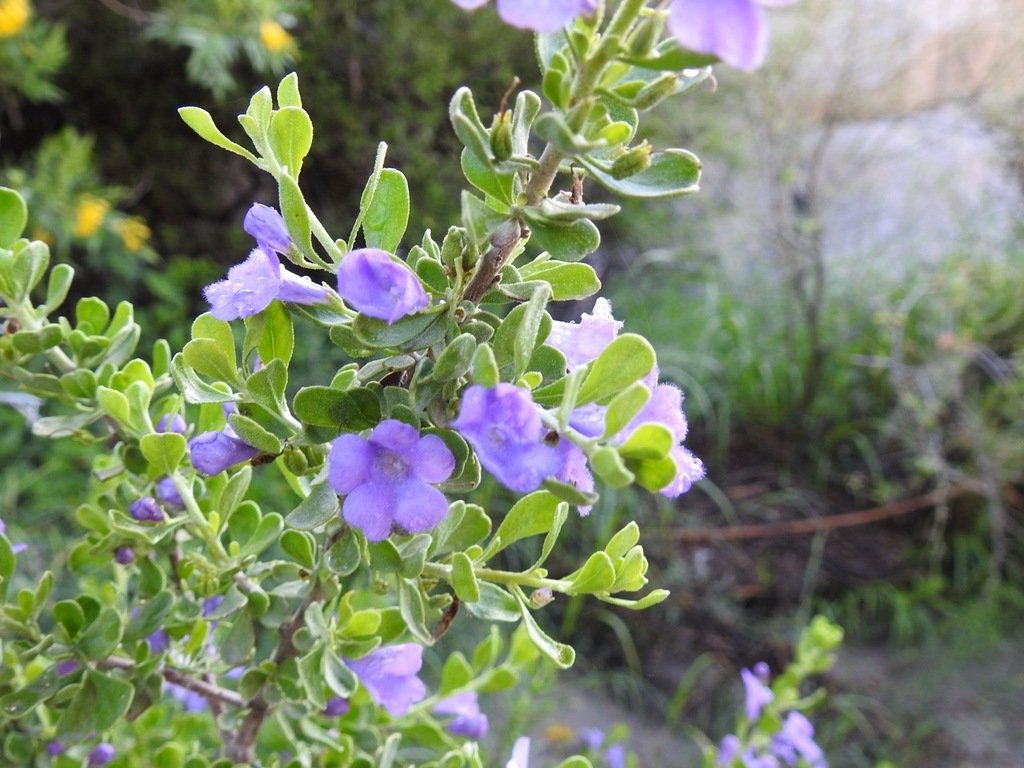The Genus Leucophyllum
Rangers
Family: Scrophulariaceae
The plants in this genus of the southwestern United States and Mexico have become landscape stapes throughout the arid southwest. There are 17 species, though only a relative handful of species have been grown in the trade. There are numerous selections and hybrids as well. We will only profile the species here so you understand the basic differences between them.
These plants have numerous common names. Many people refer to them as “sages” but they are not related to the genus of sages (Salvia spp) at all. They are called such because the vaguely resemble some sages. They are commonly known as cenizo in Spanish.
Rangers are legendary for their ability to "forecast" rain, usually blooming several days prior to a rainstorm, apparently in response to humidity. They are sometimes called "barometer bush" for this reason. It is believed to be a survival trait in the plants' semi-desert habitats (many of the native bee species they depend on for pollination come out during the rains). It should be noted, however, that barometers read barometric pressure, and that isn’t what Leucophyllums respond to—they respond to humidity.
Photo of Leucophyllum revolutum by Mountain States Wholesale Nursery.
Leucophyllum candidum
Violet Silverleaf
Evergreen (silver) shrub growing to about 3’ tall and wide, rarely to 4’. Foliage is smaller and silvery. Flower color ranges from light purple to very deep purple and occur during summer monsoons. This is a more compact, smaller plant than many of the other Leucophyllum species found in nurseries.
The horticultural selections 'Silver Cloud', is known for its rich purple flowers and silvery leaves, and 'Thunder Cloud', is smaller and more floriferous than 'Silver Cloud'.
Full sun, moderate to low water (when established). Provide soil with good drainage. Cold hardy to 10°F.
Larval food plant for the theona checkerspot butterfly (Chlosyne theona) and the calleta silkmoth (Eupackardia calleta). Nectar rich flowers enjoyed by many insects and birds. Native bees are important to Leucophyllum species.
The genus name Leucophyllum comes from the Greek leucos meaning white and phyllon meaning white for the whitish foliage of many species in the genus. The species name candidum is from Latin meaning "white; pure; sincere, honest, upright," from candere "to shine" redundantly referring to the silvery foliage.
Found in limestone hills, canyons, steep slopes, gravelly slopes, flats, and roadsides in Texas south into Nuevo Leon.
Leucophyllum candidum on iNaturalist
Photo by Mountain States Wholesale Nursery
Leucophyllum Frutescens
Texas Ranger
This species includes many selections that can have green or silver leaves, evergreen, growing up to 8’ tall if unpruned, often kept at about 5-6’ tall. Some selections stay at 5-6’ tall without pruning. This species flowers when humidity increases, especially during monsoon and the flower colors range from white to pink to lavender or purple. These plants are evergreen, but the inner foliage may yellow a bit in winter—this happens more to plants in containers than in the ground.
Green Cloud - green foliage with pinkish flowers
Compacta - Silvery foliage, compact plant (5x5), pink flowers
White Cloud - Silvery foliage with white flowers
Convent - vibrant dark pink flowers and compact growth
Bertstar Dwarf - Small, distinctively globose habit and dense and persistent leafiness
Heavenly Cloud - Hybrid with Leucophyllum laevigatum, green, smaller foliage, lavender flowers, 6x6’
Purple Rain - Another hybrid with L. laevigatum, with dense growth form, pleasantly fragrant lavender flowers, and supposedly more disease resistant
Plant in full sun and provide moderate to low water when established. This species can live on rainfall when it is fully established. It is important to ensure good drainage. Cold hardy to 5°F.
Larval food plant for the theona checkerspot butterfly (Chlosyne theona) and the calleta silkmoth (Eupackardia calleta). Nectar rich flowers enjoyed by many insects and birds. Native bees are important to Leucophyllum species.
This species is the official "State Native Shrub of Texas".
The genus name Leucophyllum comes from the Greek leucos meaning white and phyllon meaning white for the whitish foliage of many species in the genus, while frutescens is derived from the Latin frutico, which means “to become shrubby”.
This shrub is native to rocky limestone slopes in calcareous soils in the Chihuahuan Desert extending from northern Mexico into Texas and New Mexico.
Leucophyllum frutescens on iNaturalist
Photo by Mountain States Wholesale Nursery
Leucophyllum laevigatum
Chihuahuan Ranger
Growing to about 5’ high and wide this species usually has a loose, spiky form and small olive-green leaves. Flowers can emerge with the humidity and heat of summer monsoon, with flower colors ranging from blueish purple to pinkish, to white though Chihuahuan-sage doesn’t seem to be as dependent on humidity and warmth to bloom as the other Leucophyllum species. The flowers are also fragrant. The foliage is green and more slender than other rangers.
Summer Snow - A selection with white flowers
Provide full sun, moderate to water when established, hardy to 10°F.
Larval food plant for the theona checkerspot butterfly (Chlosyne theona) and the calleta silkmoth (Eupackardia calleta). Nectar rich flowers enjoyed by many insects and birds.
The genus name Leucophyllum comes from the Greek leucos meaning white and phyllon meaning white for the whitish foliage of many species in the genus, while the specific epithet (laevigatum) is from a Latin word meaning "made smooth" or "having a polished surface" referring to the texture of the leaves of this plant.
Found on rocky slopes of high Chihuahuan desert at 4,000 to 8,000 ft. in Chihuahua, Durango, Coahuila, and Tamaulipas.
Leucophyllum langmaniae
Rio Bravo Ranger
The wild plant is usually seen at about 3’ tall but can get to 5’ (the horticultural selections available in the trade tend to get to 5’). Flowers with lavender blooms, usually in response to summer humidity.
Lynn’s Legacy - Has the longest blooming season of any ranger and doesn’t seem to need the humidity to trigger blooming.
Rio Bravo - Has a rounded form, with lush, deep green leaves. Sprinkles of lavender flowers
Full sun, moderate water, hardy to 10°F.
Larval food plant for the theona checkerspot butterfly (Chlosyne theona) and the calleta silkmoth (Eupackardia calleta). Nectar rich flowers enjoyed by many insects and birds. Native bees are important to species of Leucophyllum.
The genus name Leucophyllum comes from the Greek leucos meaning white and phyllon meaning white for the whitish foliage of many species in the genus, while the specific epithet honors 20th century American botanist Ida Kaplan Langman, a Russian Empire-born, American botanist. She made two long expeditions in Mexico from 1939 to 1941 and from 1948 to 1949. She is best known as the author of A Selected Guide to the Literature on the Flowering Plants of Mexico (1964).
Found in ditches, ravines, depressions, hillsides, slopes from Texas, south into Nuevo Leon.
Leucophyllum minus
Big Bend Silverleaf
This is the most cold hardy of all the Leucophyllums, and is a smaller, deciduous plant growing to about 2-3’ tall, occasionally to 5’. The foliage is silver and may not be deciduous in Tucson, especially during the warmer winters. Purple to blue flowers, like all Leucophyllums, appear as a response to monsoon humidity. The plain species is difficult to find in the trade because it is difficult to propagate.
Rain Cloud - a hybrid with L. frutescens with silvery gray foliage and intense purple flowers, very vertical growth form
Full sun, moderate water with good drainage, hardy to -10°F.
Larval food plant for the theona checkerspot butterfly (Chlosyne theona) and the calleta silkmoth (Eupackardia calleta). Nectar rich flowers enjoyed by many insects and birds.
The genus name Leucophyllum comes from the Greek leucos meaning white and phyllon meaning white for the whitish foliage of many species in the genus, while minus means “less” perhaps referring to the smaller foliage of the plant.
Its native habitat is rocky limestone flats, slopes and mountains in the Trans Pecos and into Mexico and New Mexico south into Nuevo Leon with a disjunct population in Tamaulipas.
Leucophyllum pruinosum
Fragrant Ranger
Large silver shrub reaching up to 8 feet tall, though usually seen at 6’. Full sun, moderate water, hardy to 10°F. Lavender, fragrant flowers bloom in response to a rise in humidity, especially during monsoon. The flowers are particularly aromatic at night into the late morning.
Sierra Bouquet - has an open habit and intensely bubblegum scented flowers
Larval food plant for the theona checkerspot butterfly (Chlosyne theona) and the calleta silkmoth (Eupackardia calleta). Nectar rich flowers enjoyed by many insects and birds. Native bees are important to species of Leucophyllum.
The genus name Leucophyllum comes from the Greek leucos meaning white and phyllon meaning white for the whitish foliage of many species in the genus, while pruinosum is from the Latin 'pruinosus' meaning frosted, referring to the frosty look of the foliage.
Native to slopes and open areas in Tamaulipas, Mexico.
Leucophyllum revolutum
Sierra Ranger
Evergreen shrub reaching about 4’ tall and 5’ wide. Purple flowers occur in response to a rise in humidity, especially during monsoon. The foliage texture is almost succulent and looks like rosemary from the distance.
Full sun, moderate water, hardy to 5°F.
Larval food plant for the theona checkerspot butterfly (Chlosyne theona) and the calleta silkmoth (Eupackardia calleta). Nectar rich flowers enjoyed by many insects and birds. Leucophyllums are important to native bees.
The genus name Leucophyllum comes from the Greek leucos meaning white and phyllon meaning white for the whitish foliage of many species in the genus, while revolutum comes from the latin revolutus meaning 'rolled' or 'revolved' referring to the foliage of the species.
Native to Tamaulipas in open and disturbed soils.
Leucophyllum revolutum on iNaturalist
Photo by Mountain States Wholesale Nursery







